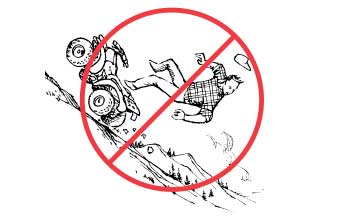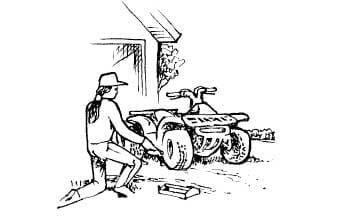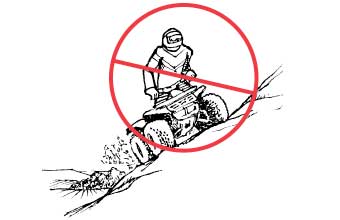Safe Operation of All-Terrain Vehicles
Here are some key points.
- Always wear a U. S. Department of Transportation-approved helmet and protective clothing when operating an ATV.
- Never allow passengers on an ATV.
- Be especially careful when you are pulling a load.
ATVs can be dangerous
- All-terrain vehicles are becoming more and more popular on farms.
- ATVs can make your job easier by getting you from one place to another quickly and by helping you haul loads over rough terrain.
- But ATVs are also dangerous. Each year, thousands of people are injured – and hundreds are killed – in ATV accidents.
- The majority of these injuries occur when:
- operators lose control
- vehicles roll over
- operators are thrown from ATVs
- an ATV collides with a tree or other obstacle
- The most serious injuries occur when ATV operators are not wearing helmets or other protective equipment.

The most serious injuries occur when ATV operators are not wearing helmets or other protective equipment.

Inspect the ATV for adequate tire pressure, fuel and oil levels, and working lights and switches. The operator’s manual will indicate other parts to check.

Don’t climb hills that are too steep to handle.
What you wear is important
- Before you operate an ATV, be sure you are wearing:
- A helmet to protect you from a head injury. Full-face helmets are the best. Be sure the helmet states it has been U. S. Department of Transportation (DOT)-approved.
- Goggles to protect your eyes.
- Sturdy gloves.
- Boots that lace over your ankles.
- A long-sleeved shirt and long pants.
Operating an ATV
- Review the operator’s manual so you’re familiar with the engine stop switch, hand and foot controls, and other parts. See your supervisor if you have any questions.
- Inspect the ATV for adequate tire pressure, fuel and oil levels, and working lights and switches. The operator’s manual will indicate other parts to check.
- Know your terrain. Be aware of steep hills or slopes, extremely rough surfaces, ditches and other potential hazards.
- Know how to shift your body weight to avoid a rollover or other accident. This is especially important when you turn or climb hills.
- Don’t travel too fast, and don’t ride after dark.
- Stay off of paved surfaces and public roads. ATVs are not designed for use on paved surfaces. In addition, in most states it is illegal to operate ATVs on public roads. Check with your supervisor if you are unfamiliar with your local laws.
More ATV safety tips
- Never allow passengers on an ATV.
- Don’t ride if you have consumed alcohol.
- Don’t allow children to operate ATVs.
- Always keep your feet on the footrests and your hands on the handlebars when you are riding.
- Don’t climb hills that are too steep to handle. And avoid crossing steep or slippery slopes.
- Be extra careful when you are pulling a load. Turn slowly and evenly, and make sure the load is securely attached.
- Know the weight limits your ATV is designed to handle. Check the operating manual or ask your supervisor.
- Stay alert when operating an ATV. Watch out for flying debris and other unexpected hazards.
ATV Safety Do’s and Don’ts
Do
- Always wear a helmet, goggles and other protective gear when operating an ATV.
- Review the operator’s manual before riding an ATV.
- Travel at moderate speeds and during daylight hours.
- Pull a load that’s too heavy for your ATV to handle.
- Operate an ATV on unfamiliar terrain.
- Cross steep or slippery slopes, or climb hills that are too steep to handle.
When you’re ready to work safely, you’re ready to work. See our full line of safety supplies, including respirators, eye and ear protection, coveralls, first aid and more.







